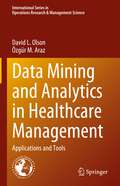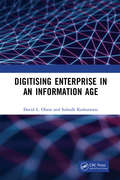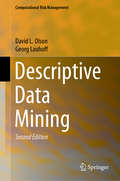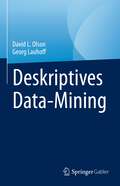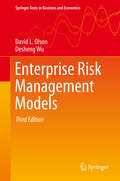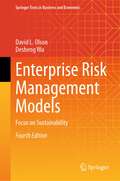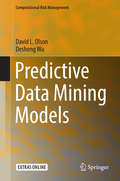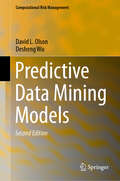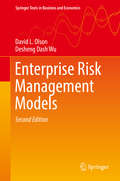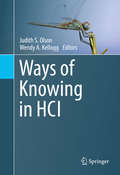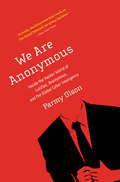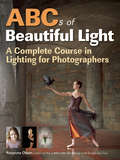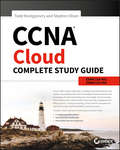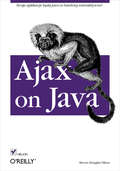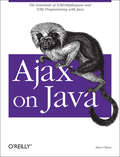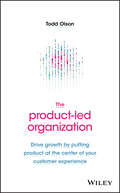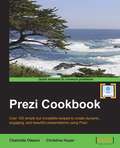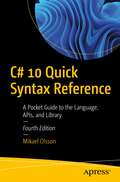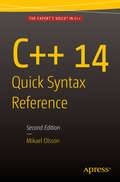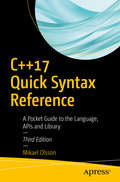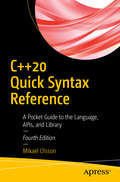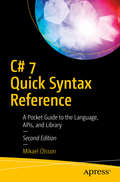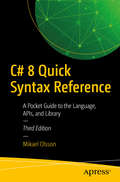- Table View
- List View
Data Mining and Analytics in Healthcare Management: Applications and Tools (International Series in Operations Research & Management Science #341)
by David L. Olson Özgür M. ArazThis book presents data mining methods in the field of healthcare management in a practical way. Healthcare quality and disease prevention are essential in today’s world. Healthcare management faces a number of challenges, e.g. reducing patient growth through disease prevention, stopping or slowing disease progression, and reducing healthcare costs while improving quality of care. The book provides an overview of current healthcare management problems and highlights how analytics and knowledge management have been used to better cope with them. It then demonstrates how to use descriptive and predictive analytics tools to help address these challenges. In closing, it presents applications of software solutions in the context of healthcare management. Given its scope, the book will appeal to a broad readership, from researchers and students in the operations research and management field to practitioners such as data analysts and decision-makers who work in the healthcare sector.
Digitising Enterprise in an Information Age
by David L. Olson Subodh KesharwaniDigitising Enterprise in an Information Age is an effort that focuses on a very vast cluster of Enterprises and their digitising technology involvement and take us through the road map of the implementation process in them, some of them being ICT, Banking, Stock Markets, Textile Industry & ICT, Social Media, Software Quality Assurance, Information Systems Security and Risk Management, Employee Resource Planning etc. It delves on increased instances of cyber spamming and the threat that poses to e-Commerce and Banking and tools that help and Enterprise toward of such threats. To quote Confucius, “As the water shapes itself to the vessel that contains it, so does a wise man adapts himself to circumstances.” And the journey of evolution and progression will continue and institutions and enterprises will continue to become smarter and more and more technology savvy. Enterprises and businesses across all genre and spectrum are trying their level best to adopt to change and move on with the changing requirements of technology and as enterprises and companies upgrade and speed up their digital transformations and move their outdate heirloom systems to the cloud, archaic partners that don't keep up will be left behind. Note: T&F does not sell or distribute the Hardback in India, Pakistan, Nepal, Bhutan, Bangladesh and Sri Lanka.
Descriptive Data Mining (Computational Risk Management)
by David L. Olson Georg LauhoffThis book provides an overview of data mining methods demonstrated by software. Knowledge management involves application of human knowledge (epistemology) with the technological advances of our current society (computer systems) and big data, both in terms of collecting data and in analyzing it. We see three types of analytic tools. Descriptive analytics focus on reports of what has happened. Predictive analytics extend statistical and/or artificial intelligence to provide forecasting capability. It also includes classification modeling. Diagnostic analytics can apply analysis to sensor input to direct control systems automatically. Prescriptive analytics applies quantitative models to optimize systems, or at least to identify improved systems. Data mining includes descriptive and predictive modeling. Operations research includes all three. This book focuses on descriptive analytics.The book seeks to provide simple explanations and demonstration of some descriptive tools. This second edition provides more examples of big data impact, updates the content on visualization, clarifies some points, and expands coverage of association rules and cluster analysis. Chapter 1 gives an overview in the context of knowledge management. Chapter 2 discusses some basic software support to data visualization. Chapter 3 covers fundamentals of market basket analysis, and Chapter 4 provides demonstration of RFM modeling, a basic marketing data mining tool. Chapter 5 demonstrates association rule mining. Chapter 6 is a more in-depth coverage of cluster analysis. Chapter 7 discusses link analysis. Models are demonstrated using business related data. The style of the book is intended to be descriptive, seeking to explain how methods work, with some citations, but without deep scholarly reference. The data sets and software are all selected for widespread availability and access by any reader with computer links.
Deskriptives Data-Mining
by David L. Olson Georg LauhoffDieses Buch bietet einen Überblick über Data-Mining-Methoden, die durch Software veranschaulicht werden. Beim Wissensmanagement geht es um die Anwendung von menschlichem Wissen (Erkenntnistheorie) mit den technologischen Fortschritten unserer heutigen Gesellschaft (Computersysteme) und Big Data, sowohl bei der Datenerfassung als auch bei der Datenanalyse. Es gibt drei Arten von Analyseinstrumenten. Die deskriptive Analyse konzentriert sich auf Berichte über das, was passiert ist. Bei der prädiktiven Analyse werden statistische und/oder künstliche Intelligenz eingesetzt, um Vorhersagen treffen zu können. Dazu gehört auch die Modellierung von Klassifizierungen. Die diagnostische Analytik kann die Analyse von Sensoreingaben anwenden, um Kontrollsysteme automatisch zu steuern. Die präskriptive Analytik wendet quantitative Modelle an, um Systeme zu optimieren oder zumindest verbesserte Systeme zu identifizieren. Data Mining umfasst deskriptive und prädiktive Modellierung. Operations Research umfasst alle drei Bereiche. Dieses Buch konzentriert sich auf die deskriptive Analytik.Das Buch versucht, einfache Erklärungen und Demonstrationen einiger deskriptiver Werkzeuge zu liefern. Es bietet Beispiele für die Auswirkungen von Big Data und erweitert die Abdeckung von Assoziationsregeln und Clusteranalysen. Kapitel 1 gibt einen Überblick im Kontext des Wissensmanagements. Kapitel 2 erörtert einige grundlegende Softwareunterstützung für die Datenvisualisierung. Kapitel 3 befasst sich mit den Grundlagen der Warenkorbanalyse, und Kapitel 4 demonstriert die RFM-Modellierung, ein grundlegendes Marketing-Data-Mining-Tool. Kapitel 5 demonstriert das Assoziationsregel-Mining. Kapitel 6 befasst sich eingehender mit der Clusteranalyse. Kapitel 7 befasst sich mit der Link-Analyse. Die Modelle werden anhand geschäftsbezogener Daten demonstriert. Der Stil des Buches ist beschreibend und versucht zu erklären, wie die Methoden funktionieren, mit einigen Zitaten, aber ohne tiefgehende wissenschaftliche Referenzen. Die Datensätze und die Software wurden so ausgewählt, dass sie für jeden Leser, der über einen Computeranschluss verfügt, weithin verfügbar und zugänglich sind.
Enterprise Risk Management Models (Springer Texts in Business and Economics)
by David L. Olson Desheng WuThis book offers a comprehensive guide to several aspects of risk, including information systems, disaster management, supply chain and disaster management perspectives. A major portion of the book is devoted to presenting a number of operations research models that have been (or could be) applied to enterprise supply risk management, especially from the supply chain perspective. Each chapter of this book can be used as a stand-alone module on a respective topic, with dedicated examples, definitions and discussion notes. This book comes at a time when the world is increasingly challenged by different forms of risk and how to manage them. Events of the 21st Century have made enterprise risk management even more critical. Risks such as suspicions surrounding top-management structures, financial and technology bubbles (especially since 2008), as well as the risk posed by terrorism, such as the 9/11 attacks in the U.S. as well as more recent events in France, Belgium, and other European countries, have a tremendous impact on many facets of business. Businesses, in fact, exist to cope with risk in their area of specialization.
Enterprise Risk Management Models: Focus on Sustainability (Springer Texts in Business and Economics)
by David L. Olson Desheng WuThis textbook, now in its fourth edition, serves as a comprehensive guide to learning various aspects of risk, encompassing supply chain management, artificial intelligence, and sustainability. It demonstrates a wide range of operations research models that have been successfully applied to enterprise supply chain risk management. Each chapter of the book can function as a standalone module focusing on a specific topic, offering dedicated examples, definitions, and discussion notes.The publication of this book comes at a crucial time when the world is facing increasing challenges from various forms of risk. Events such as Covid-19, the energy crisis, wars, and terrorism in the 21st century have all disrupted supply chains, thus highlighting the critical importance of enterprise risk management. Additional risks, such as financial and technological bubbles, along with concerns surrounding rampant artificial intelligence, contribute to a climate that demands enhanced risk management within organizations.
Predictive Data Mining Models
by David L. Olson Desheng WuThis book reviews forecasting data mining models, from basic tools for stable data through causal models, to more advanced models using trends and cycles. These models are demonstrated on the basis of business-related data, including stock indices, crude oil prices, and the price of gold. The book s main approach is above all descriptive, seeking to explain how the methods concretely work; as such, it includes selected citations, but does not go into deep scholarly reference. The data sets and software reviewed were selected for their widespread availability to all readers with internet access. "
Predictive Data Mining Models (Computational Risk Management)
by David L. Olson Desheng WuThis book provides an overview of predictive methods demonstrated by open source software modeling with Rattle (R’) and WEKA. Knowledge management involves application of human knowledge (epistemology) with the technological advances of our current society (computer systems) and big data, both in terms of collecting data and in analyzing it. We see three types of analytic tools. Descriptive analytics focus on reports of what has happened. Predictive analytics extend statistical and/or artificial intelligence to provide forecasting capability. It also includes classification modeling. Prescriptive analytics applies quantitative models to optimize systems, or at least to identify improved systems. Data mining includes descriptive and predictive modeling. Operations research includes all three. This book focuses on prescriptive analytics.The book seeks to provide simple explanations and demonstration of some descriptive tools. This second edition provides more examples of big data impact, updates the content on visualization, clarifies some points, and expands coverage of association rules and cluster analysis. Chapter 1 gives an overview in the context of knowledge management. Chapter 2 discusses some basic data types. Chapter 3 covers fundamentals time series modeling tools, and Chapter 4 provides demonstration of multiple regression modeling. Chapter 5 demonstrates regression tree modeling. Chapter 6 presents autoregressive/integrated/moving average models, as well as GARCH models. Chapter 7 covers the set of data mining tools used in classification, to include special variants support vector machines, random forests, and boosting. Models are demonstrated using business related data. The style of the book is intended to be descriptive, seeking to explain how methods work, with some citations, but without deep scholarly reference. The data sets and software are all selected for widespread availability and access by any reader with computer links.
Enterprise Risk Management Models (Springer Texts in Business and Economics)
by David L. Olson Desheng Dash WuThis book is a comprehensive guide to several aspects of risk, including information systems, disaster management, supply chain and disaster management perspectives. A major portion of this book is devoted to presenting a number of operations research models that have been (or could be) applied to enterprise supply risk management, especially from the supply chain perspective. Each chapter of this book can be used as a unique module on a different topics with dedicated examples, definitions and discussion notes.This book comes at a time when the world is increasingly challenged by different forms of risk and how to manage them. Events of the 21st Century have made enterprise risk management even more critical. Risks such as suspicions surrounding top-management structures, financial and technology bubbles (especially since 2008), as well as the demonstrated risk from terrorism, such as the 9/11 attack in the U.S. as well as more recent events in France, Belgium, and other locations in Europe, have a tremendous impact on many facets of business. Businesses, in fact, exist to cope with risk in their area of specialization.
Ways of Knowing in HCI
by Judith S. Olson Wendy A. KelloggThis textbook brings together both new and traditional research methods in Human Computer Interaction (HCI). Research methods include interviews and observations, ethnography, grounded theory and analysis of digital traces of behavior. Readers will gain an understanding of the type of knowledge each method provides, its disciplinary roots and how each contributes to understanding users, user behavior and the context of use. The background context, clear explanations and sample exercises make this an ideal textbook for graduate students, as well as a valuable reference for researchers and practitioners. 'It is an impressive collection in terms of the level of detail and variety. ' (M. Sasikumar, ACM Computing Reviews #CR144066)
We Are Anonymous: Inside the Hacker World of LulzSec, Anonymous, and the Global Cyber Insurgency
by Parmy OlsonA thrilling, exclusive expose of the hacker collectives Anonymous and LulzSec. WE ARE ANONYMOUS is the first full account of how a loosely assembled group of hackers scattered across the globe formed a new kind of insurgency, seized headlines, and tortured the feds-and the ultimate betrayal that would eventually bring them down. Parmy Olson goes behind the headlines and into the world of Anonymous and LulzSec with unprecedented access, drawing upon hundreds of conversations with the hackers themselves, including exclusive interviews with all six core members of LulzSec. In late 2010, thousands of hacktivists joined a mass digital assault on the websites of VISA, MasterCard, and PayPal to protest their treatment of WikiLeaks. Other targets were wide ranging-the websites of corporations from Sony Entertainment and Fox to the Vatican and the Church of Scientology were hacked, defaced, and embarrassed-and the message was that no one was safe. Thousands of user accounts from pornography websites were released, exposing government employees and military personnel.Although some attacks were perpetrated by masses of users who were rallied on the message boards of 4Chan, many others were masterminded by a small, tight-knit group of hackers who formed a splinter group of Anonymous called LulzSec. The legend of Anonymous and LulzSec grew in the wake of each ambitious hack. But how were they penetrating intricate corporate security systems? Were they anarchists or activists? Teams or lone wolves? A cabal of skilled hackers or a disorganized bunch of kids?WE ARE ANONYMOUS delves deep into the internet's underbelly to tell the incredible full story of the global cyber insurgency movement, and its implications for the future of computer security.
ABCs of Beautiful Light
by Rosanne Olson"Light is a language, it takes practice to become fluent". This is the premise of the ABCs of Beautiful Light. In this book, Rosanne Olson presents lessons and insight from her many years both in the photographic industry and as a teacher. These are time-tested techniques that leave her clients and students pleased time and time again. Presented in a format that allows the reader to progress at their own pace, this book is sure to leave a lasting impact on any photographer who dives in. The book begins with the fundamentals of photography. Olson leads the reader through the basic functions of the camera, from metering & exposure, to the uses of the digital files and how to manage them. Laying out this groundwork puts the reader in the right position to proceed with the lessons in the book. From there, the importance and concepts of design are explained. While the book focuses on lighting, the understanding of design is essential to creating compelling, memorable photos.
ABCs of Beautiful Light
by Rosanne OlsonEverything we see is lit by one source or another. The questions are: what and how? That is what this book is designed to teach you. Through Roseanne Olson's tried-and-true course on lighting principles for photography, video, and art in general, you will discover how the angles and heights of your light sources affect your pictures. You will learn how to work with light modifiers to change the quality of your light, and how to control light to create a feeling of depth and dimension--whether you're shooting with natural light, continuous artificial light, studio strobes, dedicated flash, or a combination of sources. Assignments are included to help you put each concept into practice as you perfect your skills and train your eyes to see the subtleties of light. You will never look at a photograph or painting in the same way after you read this book!
CCNA Cloud Complete Study Guide: Exam 210-451 and Exam 210-455
by Stephen Olson Todd MontgomeryIncrease the value of your organization’s cloud network—and invest in your education The Cisco Cloud certification validates the skill set of individuals on industry-leading cloud solutions and best practices, as well as offering job role-based curricula for all levels of an IT staff. CCNA Cloud Complete Study Guide prepares you to take two required exams: 210-451, Understanding Cisco Cloud Fundamentals, and 210-455, Introducing Cisco Cloud Administration. It covers everything you can expect to encounter on the exams and also gives you a year of FREE access to Sybex's superior online interactive learning environment and test bank, including chapter tests, practice exams, a glossary of key terms, and electronic flashcards. Cisco’s CCNA Cloud certification covers cloud characteristics and models, cloud deployment, and basic knowledge of cloud compute, cloud networking, and cloud storage. It also covers cloud infrastructure administration and reporting, chargeback and billing reports, cloud provisioning, cloud systems management and monitoring, and cloud remediation. With thorough coverage, practical instruction, and expert insight, this book provides an ideal resource for Exam 210-451 and Exam 210-455 preparation. • Includes an opening list of exam topics • Provides valuable hands-on exercises • Offers practical real-world examples • Distills in-depth perspective from cloud computing experts This book is the perfect resource for anyone seeking to earn the challenging, but rewarding CCNA Cloud certification.
Ajax on Java
by Steven Douglas OlsonTwoje aplikacje jeszcze bardziej interaktywne! Jak integrowa? funkcje Ajaksa z aplikacjami JSP? Jak korzysta? z dost?pnych bibliotek znaczników i tworzy? w?asne? Jak ?šczy? techniki Ajax i Struts? Technologia Ajax oparta na kodzie Java gwarantuje uzyskanie prawdziwej interaktywno?ci witryny internetowej, wysoce komfortowej zarówno dla u?ytkownika, jak i jej administratora. Wielo?? zestawów narz?dziowych i technik umo?liwia maksymalne uproszczenie i przyspieszenie pracy webmastera. Zaimplementowanie Ajaksa w aplikacjach pisanych w j?zyku Java pozwala na uzyskanie niemal wszystkich efektów potrzebnych do sprawnego funkcjonowania dynamicznej strony WWW bez konieczno?ci wykorzystywania innych technologii. Ksiš?ka "Ajax on Java" to wprowadzenie do technologii Ajax, które pokazuje, jak wzbogaca? o funkcje ajaksowe aplikacje oparte na serwletach, aplikacje JSP, JSF i inne. Dzi?ki temu podr?cznikowi nauczysz si? tworzy? bardziej interaktywne, dynamiczne i efektowne strony internetowe poprzez wyeliminowanie pracoch?onnego wpisywania danych przez u?ytkownika i irytujšcego oczekiwania na od?wie?enie strony. Poznasz równie? kilka sposobów organizowania komunikacji pomi?dzy klientem a serwerem, w tym wykorzystanie formatów JSON, umo?liwiajšcych przesy?anie danych o bardziej z?o?onej strukturze. Krótko mówišc, ksiš?ka "Ajax on Java" podniesie Twoje umiej?tno?ci programowania na wy?szy poziom. Budowanie i instalowanie aplikacji Ajax Integrowanie funkcji Ajax z aplikacjami JSP Metody tworzenia dokumentów XML Tworzenie biblioteki znaczników Pobieranie i instalowanie biblioteki Ajax Pisanie kodu JSP z wykorzystaniem Struts-Layout Konfigurowanie serwletów Wykorzystywanie zestawu narz?dziowego GWT Wyszukiwanie b??dów w kodzie aplikacji Ajax on Java -- komfort webmasterów i u?ytkowników!
Ajax on Java: The Essentials of XMLHttpRequest and XML Programming with Java
by Steven Douglas OlsonThis practical guide shows you how to make your Java web applications more responsive and dynamic by incorporating new Ajaxian features, including suggestion lists, drag-and-drop, and more. Java developers can choose between many different ways of incorporating Ajax, from building JavaScript into your applications "by hand" to using the new Google Web Toolkit (GWT). Ajax on Java starts with an introduction to Ajax, showing you how to write some basic applications that use client-side JavaScript to request information from a Java servlet and display it without doing a full page reload. It also presents several strategies for communicating between the client and the server, including sending raw data, and using XML or JSON (JavaScript Object Notation) for sending more complex collections of data. The book then branches out into different approaches for incorporating Ajax, which include: The Prototype and script.aculo.us Javascript libraries, the Dojo and Rico libraries, and DWR Integrating Ajax into Java ServerPages (JSP) applications Using Ajax with Struts Integrating Ajax into Java ServerFaces (JSF) applications Using Google's GWT, which offers a pure Java approach to developing web applications: your client-side components are written in Java, and compiled into HTML and JavaScript Ajax gives web developers the ability to build applications that are more interactive, more dynamic, more exciting and enjoyable for your users. If you're a Java developer and haven't tried Ajax, but would like to get started, this book is essential. Your users will be grateful.
Ajax on Java
by Steven Douglas Olson Steve OuallineDevelopers are charged with building applications that are dynamic, interactive and exciting, but they also must eat and sleep. Ajax allows a request from a web page to go to the server, get data and display it without bothering the user. The results are web applications that have the responsiveness of sophisticated applications. Consultant and practitioner Olson offers those new to Java the basics and moves up to advanced ideas at a brisk pace. He begins with setup, then advances to creating the application, building and deploying it, setting up XML documents and passing data with ISON, getting useful data (as in forms and suggestion fields), using libraries and toolkits, using DWR, building drag-and-drop functions, creating Ajax tags and libraries, using Struts, combining JavaServer Faces and Ajax, and getting past "handmade" with the Google Web Toolkit. Examples abound, as do illustrations. Annotation ©2008 Book News, Inc. , Portland, OR (booknews. com)
The Product-Led Organization: Drive Growth By Putting Product at the Center of Your Customer Experience
by Todd OlsonA playbook on product-led strategy for software product teams There's a common strategy used by the fastest growing and most successful businesses of our time. These companies are building their entire customer experience around their digital products, delivering software that is simple, intuitive and delightful, and that anticipates and exceeds the evolving needs of users. Product-led organizations make their products the vehicle for acquiring and retaining customers, driving growth, and influencing organizational priorities. They represent the future of business in a digital-first world. This book is meant to help you transform your company into a product-led organization, helping to drive growth for your business and advance your own career. It provides: A holistic view of the quantitative and qualitative insights teams need to make better decisions and shape better product experiences. A guide to setting goals for product success and measuring progress toward meeting them. A playbook for incorporating sales and marketing activities, service and support, as well as onboarding and education into the product Strategies for soliciting, organizing and prioritizing feedback from customers and other stakeholders; and how to use those inputs to create an effective product roadmap The Product-Led Organization: Drive Growth By Putting Product at the Center of Your Customer Experience was written by the co-founder and CEO of Pendo—a SaaS company and innovator in building software for digital product teams. The book reflects the author’s passion and dedication for sharing what it takes to build great products.
Prezi Cookbook
by Charlotte Olsson Christina HoyerThis book is intended for both beginners who want to get started with Prezi as well as experienced users who want to enhance their knowledge of Prezi. If you are a seasoned presenter, you can use this book to quickly transfer your presentation skills to Prezi. If you are new to presenting, the guidelines and tips in this book take you by the hand and guide you to complete mastery of Prezi.
C# 10 Quick Syntax Reference: A Pocket Guide to the Language, APIs, and Library
by Mikael OlssonDiscover what's new in C# and .NET for Windows programming. This book is a condensed code and syntax reference to the C# programming language, updated with the latest features of version 10 for .NET 6. You'll review the essential C# 10 and earlier syntax, not previously covered, in a well-organized format that can be used as a handy reference. Specifically, unions, generic attributes, CallerArgumentExpression, params span, Records, Init only setters, Top-level statements, Pattern matching enhancements, Native sized integers, Function pointers and more.You'll find a concise reference to the C# language syntax: short, simple, and focused code examples; a well laid out table of contents; and a comprehensive index allowing easy review. You won’t find any technical jargon, bloated samples, drawn-out history lessons, or witty stories. What you will find is a language reference that is to the point and highly accessible. The book is a must-have for any C# programmer.What You Will LearnEmploy nullable reference types Work with ranges and indices Apply recursive patterns to your applicationsUse switch expressions Who This Book Is ForThose with some experience in programming, looking for a quick, handy reference. Some C# or .NET recommended but not necessary.
C++ 14 Quick Syntax Reference: Second Edition
by Mikael OlssonThis updated handy quick C++ 14 guide is a condensed code and syntax reference based on the newly updated C++ 14 release of the popular programming language. It presents the essential C++ syntax in a well-organized format that can be used as a handy reference. You won't find any technical jargon, bloated samples, drawn out history lessons, or witty stories in this book. What you will find is a language reference that is concise, to the point and highly accessible. The book is packed with useful information and is a must-have for any C++ programmer. In the C++ 14 Quick Syntax Reference, Second Edition, you will find a concise reference to the C++ 14 language syntax. It has short, simple, and focused code examples. This book includes a well laid out table of contents and a comprehensive index allowing for easy review. What you'll learn How to create a C++ HelloWorld How to compile and run What are C++ variables, operators, pointers and references What are arrays, strings, conditionals, loops and more How to write functions How to work with constructors, inheritance, overridings How to use access levels, static, enum, string and union, and more What are custom conversions, namespaces, constants, and preprocessors How to do event handling What are type conversions, templates, headers, and more Who this book is for This book is a quick, handy pocket syntax reference for experienced C++ programmers, and a concise, easily-digested introduction for other programmers new to C++. Table of Contents 1. HelloWorld 2. Compile and Run 3. Variables 4. Operators 5. Pointers 6. References 7. Arrays 8. String 9. Conditionals 10. Loops 11. Functions 12. Class 13. Constructor 14. Inheritance 15. Overriding 16. Access Levels 17. Static 18. Enum 19. String and Union 20. Operator Overloading 21. Custom Conversions 22. Namespaces 23. Constants 24. Preprocessor 25. Event Handling 26. Type Conversions 27. Templates 28. Headers
C++17 Quick Syntax Reference: A Pocket Guide To The Language, Apis And Library
by Mikael OlssonThis quick C++17 guide is a condensed code and syntax reference to the popular programming language, fully updated for C++17. It presents the essential C++ syntax in a well-organized format that can be used as a handy reference.In the C++17 Quick Syntax Reference, you will find short, simple, and focused code examples. This book includes a well laid out table of contents and a comprehensive index allowing for easy review. You won’t find any technical jargon, bloated samples, drawn out history lessons, or witty stories in this book. What you will find is a language reference that is concise, to the point and highly accessible. The book is packed with useful information and is a must-have for any C++ programmer.What You'll LearnUse template argument deduction for class templatesDeclare non-type template parameters with auto-folding expressions and auto deduction from braced-init-listApply lambdas and lambda capture by valueWork with inline variables, nested namespaces, structured bindings, and selection statements with initializerUse utf-8 character literalsCarry out direct-list initialization of enumsUse these new C++17 library features or class templates from std::variant, optional, any, string_view, invoke, apply and moreDo splicing for maps and sets, also new to C++17Who This Book Is ForExperienced C++ programmers. Additionally, this is a concise, easily-digested introduction for other programmers new to C++.
C++20 Quick Syntax Reference: A Pocket Guide to the Language, APIs, and Library
by Mikael OlssonThis quick C++ 20 guide is a condensed code and syntax reference to the popular programming language, fully updated for C++20. It presents the essential C++20 code syntax in a well-organized format that can be used as a handy reference. This edition covers topics including designated initializers, lambdas and lambda captures, the spaceship operator, pack expressions, string literals as template parameters, atomic smart pointers, and contracts. It also covers library changes including extended futures, latches and barriers, task blocks, and text formatting. In the C++20 Quick Syntax Reference, you will find short, simple, and focused code examples. This book includes a well-laid-out table of contents and a comprehensive index allowing for easy review. You won’t find any technical jargon, bloated samples, drawn out history lessons, or witty stories in this book. What you will find is a language reference that is concise, to the point, and highly accessible. The book is packed with useful information and is a must-have for any C++ programmer. What You'll LearnDiscover the key C++20 featuresWork with concepts to constrain template argumentsUse modules as a replacement for header filesTake advantage of the three-way comparison operatorCreate immediate functions using the consteval keywordMake use of constexpr, constinit and designated initializers Who This Book Is For Experienced C++ programmers. Additionally, this is a concise, easily-digested introduction for other programmers new to C++.
C# 7 Quick Syntax Reference: A Pocket Guide To The Language, Apis, And Library
by Mikael OlssonThis quick C# 7 guide is a condensed code and syntax reference to the C# programming language, updated with the latest features of C# 7.3 for .NET and Windows 10. It presents the essential C# 7 syntax in a well-organized format that can be used as a handy reference.In the C# 7 Quick Syntax Reference, you will find a concise reference to the C# language syntax: short, simple, and focused code examples; a well laid out table of contents; and a comprehensive index allowing easy review. You won’t find any technical jargon, bloated samples, drawn-out history lessons, or witty stories. What you will find is a language reference that is concise, to the point, and highly accessible. The book is packed with useful information and is a must-have for any C# programmer.What You Will LearnDiscover what's new in C# 7.3 and .NET for Windows 10 programming, including out values, ref locals and returns, local functions, throw exceptions, and numeric literalsCreate lightweight, unnamed types that contain multiple public fieldsCreate branching logic based on arbitrary types and values of the members of those typesNest functions inside other functions to limit their scope and visibilityThrow expressions in code constructs that previously were not allowedDeclare methods with the async modifier to return other types in addition to TaskUse the new numeric literals found in C# 7.3 to improve readability for numeric constantsWho This Book Is ForThose with some experience in programming, looking for a quick, handy reference. Some C# or .NET recommended but not necessary.
C# 8 Quick Syntax Reference: A Pocket Guide to the Language, APIs, and Library
by Mikael OlssonThis quick C# 8 guide is a condensed code and syntax reference to the C# programming language, updated with the latest features of C# 8 for .NET and Windows 10. This book presents the essential C# 8 syntax in a well-organized format that can be used as a handy reference. Specifically, it covers nullable reference types, async streams, ranges and indices, default implementations of interface members, recursive patterns, switch expressions, target-typed new-expressions, platform dependencies and more. In the C# 8 Quick Syntax Reference, you will find a concise reference to the C# language syntax: short, simple, and focused code examples; a well laid out table of contents; and a comprehensive index allowing easy review. You won’t find any technical jargon, bloated samples, drawn-out history lessons, or witty stories. What you will find is a language reference that is to the point and highly accessible. The book is packed with useful information and is a must-have for any C# programmer.What You Will LearnDiscover what's new in C# 8 and .NET for Windows 10 programmingEmploy nullable reference types Explore the advanced async streams now available in C# 8Work with ranges and indices Apply recursive patterns to your applicationsUse switch expressions Who This Book Is ForThose with some experience in programming, looking for a quick, handy reference. Some C# or .NET recommended but not necessary.
